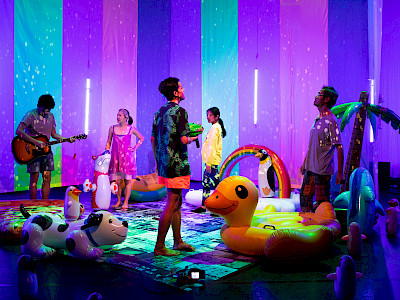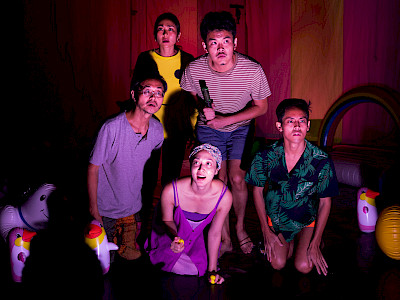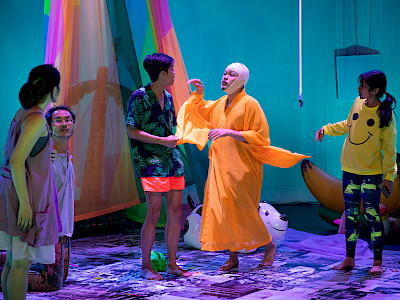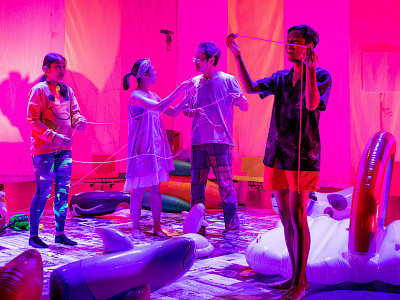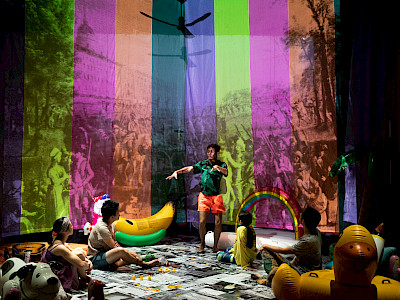01 — 04.07, 06 — 08.07.2021
Wichaya Artamat Bangkok
Four Days in September (The Missing Comrade) สี่วันในเดือนกันยา
theatre — premiere
Thai → FR, NL, EN | ⧖ 1h30 | €18 / €15
A group of friends met in September 1990 to celebrate the birthday of an old ceiling fan. Suddenly lightning strikes, they flee the place, and then return to find that one of them has disappeared. The apartment is saturated with information and absurd conversation. Someone resembling the missing person reappears. In the blink of an eye, the present becomes the past. After the success of two years ago, Wichaya Artamat returns to the festival for the second time to premiere Four Days in September (The Missing Comrade), an almost cinematic theatre piece that takes place over the course of four days. With it Artamat, alludes to thirty years of Thai history by way of several sorts of disappearance – from that of the commemorative plaque of the revolution of 1932 to the abduction of activists. Through its hypnotic intimacy and subtle acting, the piece unveils the lives of ordinary Thais forced to remain blind and silent for so long.
In 2014, When I first had an idea for this play – Four Days in September – I was contemplating the idea of a lost democracy in Thailand; whenever a coup d’etat takes place in the country, the coup leader always says that it’s a way to reform Thailand towards being a truly democratic country. Apparently, this has never been true.
In these past few years under the reign of King Rama X, there are several obvious deliberate attempt by the authorities to obliterate any memory or historical evidence of The People’s Party (a group of people who led did the Siamese Revolution in 1932, changing the governing system in Thailand from absolute monarchy to democracy). There are many disappearances of relevant objects: the Memorial Peg of 1932 Siamese Revolution at Dusit Palace Royal Plaza, the Constitution Defense Monument, and some other monuments of The People Party’s members. Some official places have been renamed, from the name of The People Party’s members to those of the royal family members. The public Dusit Zoo which used to operate on the grounds of the old royal residence has been moved elsewhere. The original Supreme Court and the Parliament House have been demolished in order to build new ones. Bangkok’s old town area, which covers several memorials of the 1932 revolution, has undergone major “landscape enhancements”.
Over the past few months during the pandemic lockdown, Thailand has been under an Emergency Decree which gives the officers absolute authority to exercise their power without liabilities. Last month (June, 2020), there was a case of a Thai satirist/activist being abducted in Cambodia, with eyewitnesses reporting that he was held up and taken away in a vehicle in front of his own apartment. There are many movements and protests following this case, and some protesters have already been issued a warrant of arrest under the emergency decree whose purpose, the government claimed, is only for controlling the virus spread. Meanwhile, some activists, politicians, and artists are reportedly being followed and running the risk of being abducted as well – just like several other previous cases of abduction, appearance, and assassination of activists and anti-government political refugees over many years.
Thailand has long been forced to live in fear and silence. There are many things we cannot talk or critique about. For me, the Thai word for being abducted – Oom-Haii – (literally meaning to carry someone and make him/her disappear) makes me think of a case back when I was a child and heard this word for the first time. It was an “Oom-Haii” of an entire family of a businessman who was somehow related to the very scandalous and mysterious case of the Blue Diamond (also known as the Saudi Jewels case), which remains “missing” to this day. All the cases of forced disappearance have recently been reconnected in my mind – an unfortunate trend in Thailand that is likely to continue in this time. This is why I’ve been reminded of my ideas for Four Days in September lately.
Four Days in September
A story of a group of friends who hang out together regularly. One day, one of them disappears. The rest of the group go on living like nothing has happened. And some time later, someone who looks like the lost friend “returns” to the group.
Scene 1 – 1st September
A group of friends parties together as usual. They sing and chat. Laughter and fun fill the atmosphere. Then, a bullet is fired somewhere outside. Some of them run outside to take a look. They come back and sit in the same seats like nothing’s happened. But one person is missing. The rest of the group is still singing and chatting. Some of them start to ask about the missing person.
Scene 2 – 11th September
The remaining people are still talking and hanging out. It’s almost the birthday of the missing person. Instead of throwing a birthday party as usual, they talk about making some merit for the missing person instead. Making merit for someone implies that the person in question is dead.
Scene 3 – 19th September
A person in the remaining group brings in somebody who looks like the missing person. But it’s not the missing person. Just a look-alike.
Scene 4 – 21st September
The entire group still sticks together. There is some kind of resolution.
As for the staging of the show, I have an image of an old-fashioned 3-blade ceiling fan hanging low from the ceiling in the middle. There’s a table with 5 chairs which look all different. A fridge. Optional wall to indicate another area which may be a kitchen or storage where the characters can smoke. The set designer will take care of other details apart from these.
- Wichaya Artamat
Presentation: Kunstenfestivaldesarts-Rideau de Bruxelles
Concept, direction: Wichaya Artamat | Text: Ratchapoom Boonbanchachoke, Wichaya Artamat | Cast: Jaturachai Srichanwanpen, Nualpanod Nat Khianpukdee, Saifah Tanthana, Suranya Poonyaphitak, Witwisit Hiranyawongkul | Dramaturgy: Ratchapoom Boonbanchachoke | Set, Light Design, Technical Direction: Pornpan Arayaveerasid, Rueangrith Suntisuk, Laphonphat Duangploy (Kinetic Design), Piti Boonsom | Soundscape Design: Chanapon Komkham | Costume: Nicha Puranasamriddhi | Make-up advisor: Punika Rangchaya | Illustration: Sina Wittayawiroj, The Art District86 | Key Visual Designer: Rueangrith Suntisuk | English Translation: Chonlatep Nabangchang | Surtitle Operator: Pathipon Adsavamahapong | Production assistant: Surat Tamjai Kaewseekram | Producer: Sasapin Siriwanij | Coproduction: Kunstenfestivaldesarts, Wiener Festwochen, Festival d’Automne à Paris, MC93 – Maison de la Culture de Seine-Saint-Denis, Black Box teater | Venue support (Thailand): Creative Economy Agency (Public Organization), Buffalo Bridge Gallery, B-Floor Theatre | Technical support (Thailand): Populight | Special Thanks: Ornanong Thaisriwong

